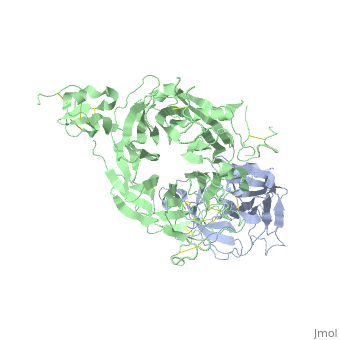Function
Hepatocyte growth factor (HGF) regulates cell growth, motility and morphogenesis. HGF binds to proto-oncogene c-Met receptor and activates a tyrosine kinase signaling cascade. HGF precursor is cleaved by serine protease to α (69 kD) and β (34 kD) chains which form a disulfide bond to produce the active heterodimer[1]. HGF α chain contains an N-terminal hairpin and 4 kringle domains. The kringle domain participates in protein-protein interaction and its structure is of a large loop which is stabilized by 3 Cys-Cys bonds. HGF β chain is catalytically inactive serine protease-like. HGF NK1 - a natural splice variant is comprised of residues 28-210 containing the N-terminus and the first kringle domain of HGF[2]. HGF NK2 variant is comprised of residues 28-289 containing the N-terminus and the first 2 kringle domains of HGF. See also Hepatocyte growth factor receptor.
Relevance
High levels of HGF are associated with liver diseases[3], lung diseases, acute cardiac infraction, vascular diseases, renal failure, neurologic diseases like Alzheimer Disease, pancreatic diseases, several types of cancer and diabetes type II[4][5]. HGF administration can reverse liver chirrosis[6].

